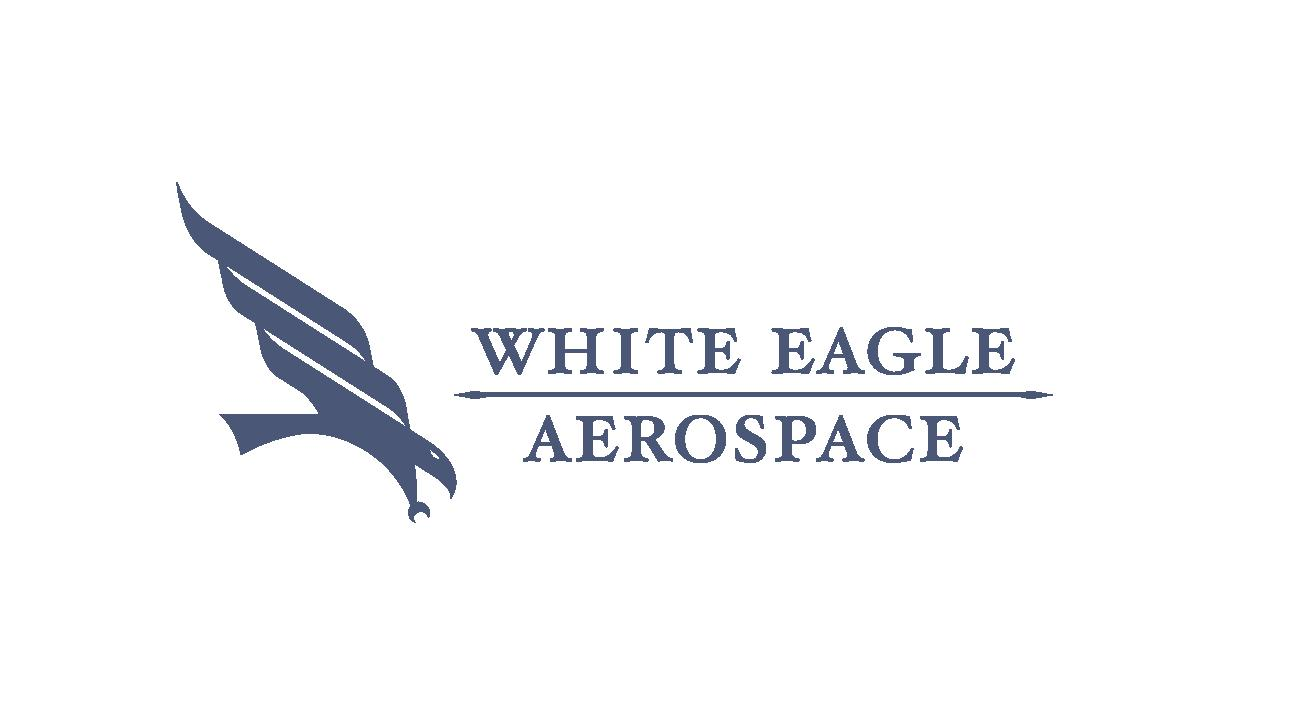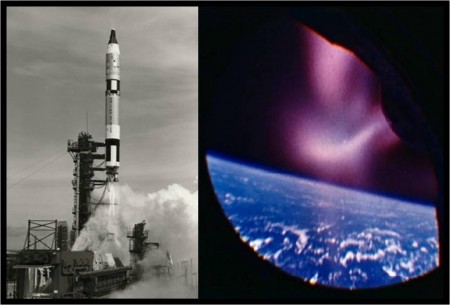
Forty-eight years ago this month, NASA successfully completed the unmanned Gemini-Titan 2 (GT-2) space mission. The suborbital spaceflight served as a final test preparatory to the first manned Gemini mission (GT-3) flown several months later.
The Gemini Program was America’s second manned space project. Gemini pioneered key technologies required to land men on the Moon including space navigation, rendezvous, docking, orbital maneuvering, long-duration spaceflight and extra-vehicular activity (EVA). Without Gemini, the United States would not have achieved the goal of landing men on the Moon before the end of the 1960’s.
The two-man Gemini spacecraft weighed 8,500 pounds at lift-off and measured 18.6 feet in length. Gemini consisted of a reentry module (RM), an adapter module (AM) and an equipment module (EM).
The crew occupied the RM which also contained ships’ navigation, communication, telemetry, electrical and reentry reaction control systems. The AM contained maneuver thrusters and the deboost rocket system. The EM included the spacecraft orbital attitude control thrusters and the fuel cell system. Both the AM and EM were used in orbit only and discarded prior to entry.
A two-stage Titan II launch vehicle served as the chariot that Gemini rode into space. Designed for the Intercontinental Ballistic Missile (ICBM) role, the native reliability of the Titan II had to be substantially improved for the vehicle to safely carry men into space. The history of spaceflight records that the man-rated Titan II truly fulfilled the measure of its creation by successfully launching ten (10) Gemini crews into earth orbit.
Gemini-Titan (GT-2) was the second and last unmanned flight test of the Gemini spacecraft. Since the primary goal was to flight-prove the craft’s heat shield performance during reentry, the mission was suborbital in nature. GT-2 lifted-off from Cape Canaveral’s LC-19 at 14:22:14 UTC on Tuesday, 19 January 1965. The vehicle’s arcing ballistic trajectory took it over the Atlantic Ocean on a flight that lasted only 18 minutes and 16 seconds. Maximum altitude and impact range were 92.4 nm and 1,847.5 nm, respectively.
Gemini 2’s ablative heat shield functioned as designed and came through the fiery reentry in excellent condition. Most of the spacecraft’s other flight systems performed satisfactorily during the vehicle’s brief sojourn into the heavens. Exceptions here included the fuel cell system which failed prior to lift-off and cooling system temperatures which exceeded design requirements.
Gemini 2’s splashdown point was located approximately 45 nm from the USS Lake Champlain. About 90 minutes after splashdown, Gemini 2 was hauled aboard the recovery ship. The spacecraft came through the flight in such good shape that it actually flew a second suborbital reentry in November of 1966. Along with the OPS 0855 boilerplate spacecraft, the Gemini 2 reentry module was flown aboard a Titan IIIC launch vehicle in support of the USAF Manned Orbiting Laboratory (MOL) Program.
The successful completion of GT-2 (along with the previous GT-1 orbital mission) provided NASA with the confidence needed to proceed with manned Gemini missions. The first of ten (10) such missions, GT-3, was successfully flown in March of 1965. A mere 20 months later (December 1966), the Gemini Program was brought to a successful conclusion with the splashdown of Gemini 12.
The Gemini Program was remarkable for its many significant and historic spaceflight achievements that paved the way to the moon. The brief mission of Gemini-Titan 2 was a small, but important part of that larger story. Today, aerospace aficionados can view the twice-flown Gemini 2 reentry module at the Air Force Space and Missile Museum, Cape Canaveral, Florida.
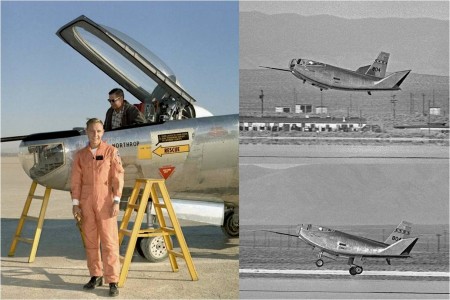
Forty-six years ago this month, the Northrop HL-10 lifting body made its first unpowered free flight. Following drop from NASA’s venerable NB-52B launch aircraft, test pilot Bruce A. Peterson successfully landed the HL-10 on Rogers Dry Lake at Edwards Air Force Base, California.
A lifting body is a wingless, aircraft-like vehicle which generates aerodynamic lift via the shape and size of its fuselage. The principal application for such a craft is in the realm of hypersonic lifting entry. The attributes of greatest interest here include the type’s favorable lift-to-drag characteristics and effective handling of the entry aerodynamic heating environment.
A true lifting body must operate at Mach numbers that range from hypersonic to subsonic. Flight controls are both aerodynamic and propulsive in nature. The former includes body flaps for pitch and roll control as well as rudders for yaw control. Propulsive thrusters are strategically arranged on the vehicle to augment control about all 3-axes at high altitude where dynamic pressure is low to negligible.
A lifting body’s unconventional shape makes the stability and control design task particularly challenging. The craft must fly at high angles-of-attack and large bank angles during hypersonic flight for trajectory ranging and aero heating accommodation purposes. Lifting bodies can also exhibit nasty lateral-directional handling qualities in the low-speed regime associated with landing.
Lifting bodies first came onto the aerospace scene in the 1960’s. An unmanned vehicle known as PRIME (Precision Recovery Including Maneuvering Entry) successfully flew a trio of suborbital flight tests between December 1966 and April 1967. High speed vehicle flight control was found to be entirely satisfactory.
A total of six (6) manned lifting body vehicles were tested at Edwards Air Force Base between 1963 and 1975. The subject aircraft included the NASA M2-F1, Northrop M2-F2, Northrop M2-F3, Martin X-24A, Martin X-24B and the Northrop HL-10. The primary purpose of this family of research vehicles was to investigate the transonic and subsonic flight characteristics of piloted lifting body aircraft.
The Northrop HL-10 measured 22.17 feet in length, 11.5 feet in height and 15.58 feet in width. The vehicle was configured with an XLR-11 rocket motor capable of generating 6,000 lbs of sea level thrust. GTOW for the single place vehicle was 9,000 lbs. NASA’s lengendary NB-52B mothership served as the launch aircraft. Drop typically took place at 450 mph and 45,000 feet.
The one and only HL-10 lifting body (S/N 804) made its inaugural free flight on Friday, 22 December 1967. NASA test pilot Bruce A. Peterson was at the controls of the tubby little ship. Since this flight was unpowered, the HL-10 was on the ground just 187 seconds after drop. The HL-10 handled well during the brief test flight and Peterson greased the landing.
The HL-10 flight test program was highly productive. Much was learned in the way of lifting body vehicle stability, control, and handling qualities. The HL-10 holds the distinction of flying higher (90,279 feet) and faster (1,227.5 mph; Mach 1.86) than any lifting body in aviation history.
The HL-10 completed a total of 37 missions (26 powered), the last of which occurred on Friday, 17 July 1970. In addition to Bruce Peterson (who, interestingly, flew only the first flight test), the aircraft was flown by John A. Manke (10 flights), William H. Dana (9 flights), Jerauld R. Gentry (9 flights) and Peter C. Hoag (8 flights).
Happily, the HL-10 airframe survived its flight test program intact. In tribute to its many aeronautical contributions, the aircraft has been preserved for posterity at Edwards Air Force Base. It is currently on public display, mounted on a pole, just outside the gate of the NASA Dryden Flight Research Center (DFRC).
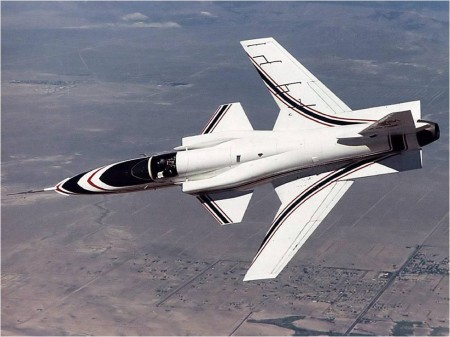
Twenty-eight years ago this month, the first DARPA/Grumman X-29A Forward Swept Wing experimental aircraft took to the air. The flight originated from Edwards Air Force Base with Grumman Chief Test Pilot Chuck Sewell at the controls.
The X-29A was designed to flight test the forward-swept wing (FSW) concept as applied to a fighter-type aircraft. The theoretical merits of this concept include greater agility, slower stall speeds, higher spin resistance, and better low-speed flight control relative to an aft-swept wing (ASW).
A key attribute of the FSW is that spanwise flow is directed from the wing tip toward the wing root. The result is that the wing root stalls before the wing tip at high angle-of-attack. This is advantageous in that a root stall is a more controllable flow condition than is a tip stall.
Due to the FSW’s inward spanwise flow, the outboard-located ailerons retain full control effectiveness since they remain in high energy air. Additionally, wing tip vortex strength is reduced and the associated drag-to-lift decreased. This results in better fuel economy and increased range performance.
Of course, these and other FSW benefits come at a price. The primary issue is related to wing structural dynamic characteristics. Due to the elastic nature of the wing structure, lift on a FSW tends to bend the wing tips upward. This deflection causes an increase in wing tip lift, which causes further bending. This problem becomes more severe with increasing aircraft speed.
The divergent structural response noted above will eventually cause the wing to structurally fail unless it is built strong enough to resist bending. Prior to the X-29A, the only solution to the FSW aeroelastic problem was to build a structually-strong, but very heavy wing. The X-29A would solve this problem through the medium of high-strength, lightweight composite wing construction.
The X-29A used an aeroelastically-tailored wing to provide the structural strength and stiffness required to effectively and safely employ its FSW. Carbon composite material was utilized to provide this weight-efficient solution to the age-old FSW structural divergence problem. The desired aeroelastic tailoring was achieved through judicious orientation of the constituent layers of carbon fiber.
In addition to aeroelastic tailoring of its wings, the X-29A also incorporated a number of other technologies to optimize its overall performance. These technologies included the use of relaxed static stability, a digital fly-by-wire flight control system, a thin supercritical airfoil section, three-surface pitch control, discrete variable-camber wing flaperons and full-authority close-coupled canards.
A pair of X-29A airframes ( S/N 82-0003 and 82-0004) were built by Grumman. These aircraft were converted from two existing Northrop F-5A Freedom Fighters. Control surface actuators and main landing gear came from the General Dynamics F-16 Fighting Falcon. The X-29A aircraft had a GTOW of 17,800 lbs. Power was supplied by a single General Electric F404 turbofan rated at 16,000 lbs of sea level thrust.
X-29A Ship No. 1 (S/N 82-0003) made its first flight on Friday, 14 December 1984 with Grumman Chief Test Pilot doing the honors. This flight took place at Edwards Air Force Base, California and was entirely satisfactory. Ship No. 1 would go on to make 254 flights before its retirement in 1990. Its stablemate (Ship No. 2, S/N 82-0049) first flew in May of 1989, flew 120 times and was retired in September 1991.
The X-29A Program was highly successful and thoroughly proved the technologies that made the FSW concept viable. Happily, both X-29A aircraft survived the type’s flight test program. Today, Ship No. 1 (S/N 82-0003) can be seen at the USAF National Museum in Dayton, OH. Ship No. 2 (S/N 82-0049) is displayed in front of the Dryden Flight Research Center located at Edwards Air Force Base, California.
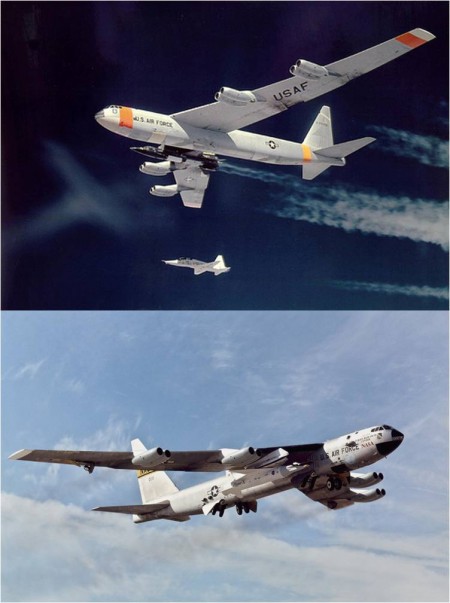
Eight years ago today, NASA’s storied NB-52B Stratofortress launch aircraft was retired following 44 years of service to the American flight research community. Although it was on flying status for nearly 50 years, the aircraft accumulated a total of only 2,443.8 flight hours.
The aircraft that became the NASA NB-52B (S/N 56-0008) started life as an RB-52B when it rolled off of the Boeing assembly line in 1955. First flight occurred on Saturday, 11 June 1955. USAF employed the aircraft as a testbed for B-52 bomb navigation systems.
In June of 1959, the aircraft joined the X-15 Program as a launch aircraft for North American’s famous manned hypersonic flight research rocket plane. Now designated as NB-52B, the eight-engine behemoth had previously been modified for the “mothership” role. The aircraft ultimately acquired the moniker “Balls 8” in deference to the last 4 digits in its USAF serial number.
Based at Edwards Air Force Base in California, the NB-52B made its X-15 Program debut on Saturday, 23 January 1960. On this day, Balls 8 launched X-15 Ship No. 1 (S/N 56-6670) with North American test pilot Scott Crossfield at the controls. It was the fifth flight test of the X-15 Program.
When the X-15 Program ended in late 1969, NASA’s NB-52B had served as the launch aircraft for roughly 140 of the X-15’s 199 research flights. But there would be many more chapters written in the hugh mothership’s story. Indeed, this story would continue to unfold over the next 35 years.
The list of flight test programs supported by Balls 8 is impressive by any measure. Among others, the NB-52B served as the launch aircraft for the legendary lifting body series (M2-F2, M2-F3, HL-10, X-24A and X-24B). Included in this list is the X-38 Crew Return Vehicle (CRV).
NASA’s NB-52B served as the first carrier aircraft for Orbital Science’s Pegasus air-launched, winged, multi-stage rocket. Balls 8 also supported the Space Shuttle Program by dropping solid rocket booster test vehicles to flight test the Shuttle booster’s parachute recovery system. The Space Shuttle Orbiter’s retro-fitted landing drogue parachute was also tested by Balls 8.
The last flight research project supported by NASA’s fabled NB-52B was the HYPER-X Program. This experimental effort involved flight testing an airframe-integrated scramjet engine on an X-aircraft known as the X-43A. Fittingly, Balls 8’s last flight test program would be like its first in that both involved hypersonic flight.
Balls 8 made its last flight on Tuesday, 16 November 2004. The mission was entirely successful as the X-43A scramjet operated at Mach 9.68 (6,598 mph at 110,000 feet). Balls 8 triumphantly returned to Edwards Air Force Base and performed one final flyover of the NASA Dryden Flight Research Center. The aircraft actually made two landings as first the co-pilot and then the command pilot landed on the concrete.
Balls 8 was officially retired on Friday, 17 December 2004 in ceremonies jointly conducted by USAF and NASA. As part of the festivities, NASA returned the NB-52B to the Air Force since technically the aircraft had been on indefinite loan to NASA since the late 1950’s! Today, the aircraft is on public display outside just the north gate at Edwards Air Force Base.
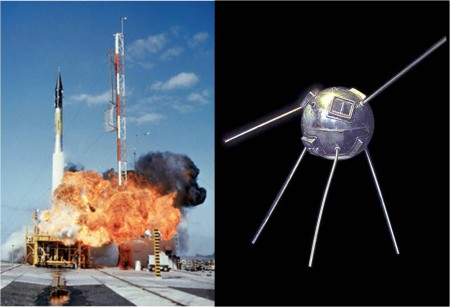
Fifty-five years ago this month, the United States attempted to launch the nation’s first satellite in response to the Soviet Union’s recent orbiting of Sputnik I. Unfortunately, the Vanguard TV-3 launch vehicle lost thrust moments after lift-off and exploded on the launch pad.
The International Geophysical Year (IGY) was a cooperative international scientific effort whose goal was to study the physical properties of the Earth. A total of sixty-seven (67) countries participated in the IGY which involved experimentation in eleven (11) physical science categories. The IGY lasted from 01 July 1957 to 31 December 1958.
Project Vanguard was established in 1955 by the United States for the purpose of orbiting the nation’s first satellite during the IGY. The Naval Research Laboratory (NRL) managed the project with the Martin Company, General Electric, Aerojet General and Grand Central Rocket Company as contractors.
Project Vanguard involved the development of both the launch vehicle and satellite payload. The Martin Company was the prime contractor for the Vanguard 3-stage launch vehicle while the NRL developed various Vanguard satellites. Launch took place from Cape Canaveral, Florida.
The Vanguard Satellite Launch Vehicle (SLV) was based on the design and technology of Martin’s single-stage Viking rocket. The SLV measured 75 feet in length and had a maximum diameter of 3.74 feet. Lift-off weight was 22,156 lbs. First, second and third stage average thrusts were rated at 30,303 lbs, 7,599 lbs and 2,599 lbs, respectively.
The original Vanguard satellite weighed a mere 3.25 lbs and included seven (7) mercury cell batteries, a pair of tracking radio transmitters, a temperature sensitive crystal, and six (6) solar cells mounted to its external surface. A total of six (6) data transmission and space tracking antennas protruded from the satellite’s spherical body as well.
On Friday, 04 October 1957, the Soviet Union orbited the world’s first artificial satellite, Sputnik I. Then, on Sunday, 03 November 1957, the Soviets orbited Sputnik II with the mongrel dog Laika onboard. These twin space feats both impressed the world and stunned the United States. As a result, success with Project Vanguard took on more significance and emphasis shifted to getting America into space pronto.
Vanguard Test Vehicle No. 3 (TV-3) was America’s first attempt to launch a Vanguard satellite into earth orbit. In truth, neither the Vanguard project nor Vanguard SLV was ready for the mission. However, the pressure to get America into space forced the project to expedite its carefully planned, but time-consuming flight test schedule. The results of doing so would not be good.
On Friday, 06 December 1957, Vanguard TV-3 lifted-off at 16:44:34 UTC from LC-18A at Cape Canaveral, Florida. Then, just 4 feet above the launch pad and 2 seconds into flight, the rocket’s first stage rocket motor lost thrust. TV-3 fell back onto the pad, rupturing its propellant tanks. The resulting massive explosion and fire totally consumed the vehicle and severely damaged the launch pad.
The TV-3 launch attempt was televised live to a worldwide audience numbering in the millions. Interestingly, the tiny Vanguard satellite somehow survived the post-crash inferno and was discovered intact at the edge of the launch complex apron. Though no longer flightworthy, the plucky satellite was dutifully beeping away as though it were in space.
The public response to the failed TV-3 mission was immediate and brutal. The ne’er-do-wells in the American press corps referred to the event with such delightfully derogatory terms as “Oopsnik”, “Kaputnik”, “Flopnik” and “Stayputnik”. However, the unkindest cut of all came from the mouth of Soviet Premier Nikita Khrushchev who mockingly described the diminutive Vanguard satellite as America’s little grapefruit.
The Vanguard Program would eventually see success. Indeed, the first Vanguard satellite (Vanguard 1) reached orbit on Monday, 17 March 1958. In fact, that satellite is still in space and is expected to remain there for at least two hundred more years. However, Vanguard 1 was Amerca’s second satellite to achieve orbit. The distinction of being first goes to the United States Army’s Explorer I satellite which was carried into orbit by a Jupiter-C launch vehicle on Friday, 31 January 1958.
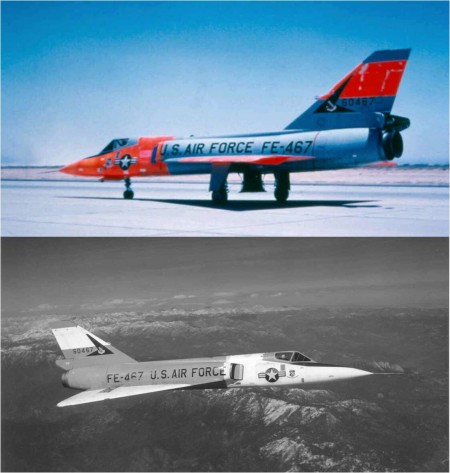
Fifty-three years ago this month, a USAF/Convair F-106A Delta Dart was clocked at 1,525.695 mph on an 11-mile straight course at Edwards Air Force Base, California. The mark still stands as an absolute speed record for single-engine turbojet-powered aircraft.
The USAF/Convair F-106 Delta Dart was designed for the all-weather interceptor role in defense of CONUS. As such, the Delta Dart’s primary mission was to seek out Soviet bomber formations and destroy same using its internally-carried missiles. Armament consisted of either (1) a quartet of Hughes AIM-4 Falcon missiles and a single AIM-26A Falcon missile or (2) a single Douglas AIR-2 Genie missile.
A member of the fabled Century Series, the Delta Dart was produced in two variants. The single place version was known as the F-106A while the dual place version was designated as the F-106B. Though primarily a trainer, this aircraft was also combat-capable. A total of 340 Delta Dart aircraft were manufactured by Convair; 277 F-106A’s and 63 F-106B’s.
The F-106A Delta Dart measured 70.7 feet in length and had a wing span of 38.25 feet. Gross Take-Off Weight (GTOW) and Empty Weight were 34,510 lbs and 24,420 lbs, respectively. Power was supplied by a single Pratt and Whitney J75-17 afterburning turbojet which produced 24,500 lbs of thrust at sea level.
The sleek Delta Dart was aerodynamically very clean. This was due in large measure to use of fuselage area ruling and a thin delta planform wing. The F-106A could climb at 29,000 feet per minute and had a service ceiling of 57,000 feet. Maximum unrefueled range was on the order of 2,700 nm.
Due to its impressive performance, USAF employed the F-106A in an attempt to regain the single-engine absolute speed record from the Soviets in late 1959. The existing record of 1,483.84 mph had been established in 1956 by a Soviet Ye-66 aircraft specially designed for setting the speed mark. The Air Force’s absolute speed record attempt was codenamed Project Firewall.
USAF originally selected F-106A (S/N 56-0459) to make the 1959 absolute speed record attempt. The aircraft was modified slightly to optimize its speed performance. However, 56-0459 experienced engine compressor stall problems and did not set the actual record. Rather, an unmodified F-106A (S/N 56-0467) was called into service and set the speed record reported here.
On Tuesday, 15 December 1959, USAF Major Joseph W. Rogers departed Edwards Air Force Base in a quest to establish a new absolute speed record for a single-engine turbojet-powered aircraft. Flying at 40,000 feet, Rogers and his F-106A averaged 1,525.695 mph over an 11-mile straight course to set a new speed mark.
For his remarkable airmanship on Project Firewall, Joe Rogers was presented with the Distinguished Flying Cross, the DeLavaulx Medal, and the Thompson Trophy. Rogers went on to a remarkable military career spanning 29 years. He retired in 1975 as a full colonel.
For its part, the Delta Dart went on to a 28-year operational life (1959-1987) with the United States Air Force and the Air National Guard. Considered by many to be the finest interceptor in aviation history, the Delta Dart is known to this day as the Ultimate Interceptor.
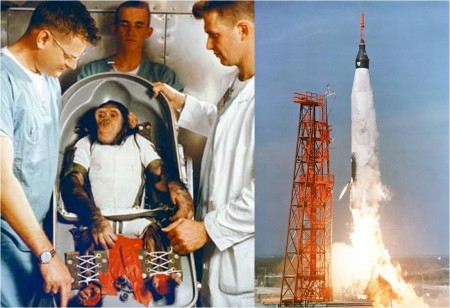
Fifty-one years ago this month, a Cameroonian chimpanzee by the name of Enos successfully flew a two-orbit mission around the Earth during the flight of Mercury-Atlas 5 (MA-5). This important mission paved the way for America’s first manned orbital spaceflight in February of 1962.
Project Mercury was the United States’ first manned spaceflight program. It consisted of two (2) suborbital and four (4) orbital manned missions flown between May 1961 and May 1963. These manned missions were preceded by animal flights in which chimpanzees served as surrogates for human crew.
A chimp named HAM successfully flew a suborbital Mercury mission in January of 1961. Known as Mercury-Redstone 2 (MR-2), this mission was a prelude to America’s first manned suborbital spaceflight in May of the same year. Flying aboard his Freedom 7 Mercury spacecraft, USN Commander Alan Bartlett Shepard, Jr. became America’s first astronaut during the flight of Mercury-Redstone 3 (MR-3).
Shepard’s pioneering spaceflight was followed by Mercury-Redstone 4 (MR-4) in July of 1961. Essentially a duplication of MR-3, USAF Captain Virgil Ivan “Gus” Grissom became America’s second astronaut. Flying his Liberty Bell 7 spacecraft, Grissom was the second member of the original Mercury Seven Astronauts to enter space.
Just as HAM’s flight preceded the successful suborbital missions of Shepard and Grissom, NASA wanted to orbit a chimp prior to the first attempt at manned orbital flight. Enter the astro-chimp Enos (which is Hebrew for “man”). Trained for spaceflight along with his backups Duane, Jim, Rocky, and HAM, Enos would fly as a passenger aboard a Mercury spacecraft. His survival would provide increased confidence that the vehicle was fit for manned orbital spaceflight.
Enos was rocketed into space from LC-14 at Cape Canaveral Florida on Wednesday, 29 November 1961. Lift-off came at 15:07:57 UTC. The Atlas LV-3B launch vehicle functioned nominally, placing the astro-chimp and his Mercury spacecraft into an elliptical orbit that measured 128 nm x 86 nm. The plan was for Enos to fly a three-orbit mission.
Other than an onboard clock that was 18 seconds too fast, Enos’ first orbit was uneventful. He performed the simple tasks for which he was trained in good fashion. When presented with a pattern of symbols, the space chimp would press one of three levers to indicate his selection. An incorrect answer would result in a mild electric shock being applied to the soles of his feet.
The Mercury spacecraft began to experience problems on Enos’ second orbit. First, the attitude control system exhibited degraded performance due to a thruster failure. Then, the environmental control system had problems maintaining the proper temperature within the spacecraft. Enos’ body temperature rose dangerously to 100.5 F and then stabilized.
However, the worst of it for Enos was that one of the three levers he used to respond to test problems malfunctioned. That meant he would receive an electrical shock even if he chose the corrrect lever! During two separate problem sessions, he incorrectly received 35 and 41 shocks, respectively. Nontheless, the plucky chimpanaut gamely continued responding to experimental inputs.
Flight controllers decided to bring Enos home one orbit early due to the above problems. Reentry came at the end of the second orbit with splashdown occurring in the Atlantic Ocean. Mission elapsed time was 3 hours, 20 minutes and 59 seconds.
It took over an hour for the USS Stormes (DD-780) to arrive on station with Enos and his spacecraft. By the time the two were fished out of the sea, brought on deck and the capsule hatch opened, Enos spent more than three hours waiting to be extracted.
Apparently, Enos did not particularly enjoy his time on the water. When handlers removed him from the spacecraft, they found that he had torn through his medical sensor garments. Most tellingly, Enos had also forcibly removed his urinary catheter while the internal anchoring balloon was still inflated.
Though Enos’ flight was far from trouble-free, the Mercury spacecraft was cleared for manned orbital flight. Indeed, history records that on Wednesday, 20 February 1962, Astronaut John Herschel Glenn, Jr. became the first American to orbit the Earth during Mercury-Atlas 6 (MA-6). Flying aboard Friendship 7, Glenn completed a three-orbit mission in 4 hours, 55 minutes and 23 seconds.
Enos the astro-chimp survived his eventful two-orbit mission none the worse for wear. However, in 1962 he contracted Shigellosis, a severe form of dysentery. Despite being treated aggressively with antibiotics and receiving constant care for two months, Enos succumbed to the illness on Sunday, 04 November 1962; less than one year after his successful space mission.
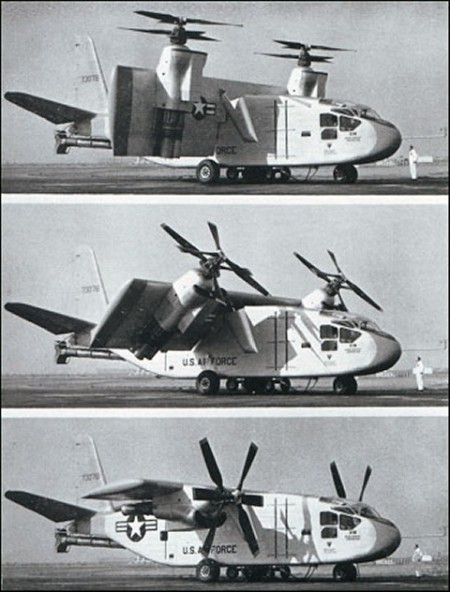
Fifty-three years ago this week, the USAF/Hiller X-18 Tilt-Wing research aircraft made its flight test debut at Edwards Air Force Base, California. Hiller test pilots George Bright and Bruce Jones were at the controls of the experimental VSTOL vehicle.
A VSTOL aircraft is one which is capable of Vertical and/or Short Take-Off and Landing. This ability to fly in the vertical provides a VSTOL aircraft with the tactical advantage of operating from small clearnings and short runways. While vertical flight is integral to it operation, a VSTOL aircraft flies the majority of its mission in horizontal flight just like conventional aircraft.
In the middle 1950’s, the rapidly-maturing state of aviation technology allowed aircraft designers to seriously consider the possibility of a VSTOL aircraft for the first time. A key technical hurdle was the transition from vertical to horizontal flight and back. To do so safely and effectively, particular attention had to be focused on aircraft flight control and propulsion.
The Hiller X-18 VSTOL aircraft employed a unique tiltable wing that permitted it to fly both in the vertical and in the horizontal. Power was provided by twin Allison YT40-A-14 turboprop engines with a maximum rating of 5,850 hp. Each powerplant drove a counter-rotating propeller having a diameter of 193-in. The overall propulsion system was capable of producing 45,000 lbs of lift.
The X-18 employed a third powerplant for aircraft pitch control. In particular, a Westinghouse J34-WE-36 turbojet with a maximum thrust of 3,400 lbs was used for this purpose. Pitch control was effected by diverting the engine’s exhaust stream through a long, ventrally-mounted tailpipe, at the end of which was located a vertically-firing nozzle.
The X-18 aircraft measured 63 feet in length and featured a unique tiltable wing having a span of 48 feet. The wing tilt mechanism could rotate the thrustline of the twin turboprops from horizontal to vertical. Gross take-off and empty weights were 33,000 lbs and 27,272 lbs, respectively. The X-18 had a top speed of 253 mph and a maximum altitude of 35,300 feet.
The one and only X-18 VSTOL aircraft (S/N 57-3078) made its first flight test on Tuesday, 24 November 1959 at Edwards Air Force Base, California. With Hiller test pilots George Bright and Bruce Jones as the air crew, the X-18 flew for 18 minutes. Maximum altitude and speed were 4,000 ft AGL and 170 knots. The test flight was entirely nominal in all respects.
The X-18 flight test program ended just a year after it began. While the aircraft was found to be quite stable and easy to control, flight safety of the type was particularly sensitive to hardware failures. An event that occurred during the twentieth (20th) and final flight of the experimental vehicle illustrates this point.
On Friday, 04 November 1960, the X-18 suddenly departed controlled flight while flying at 11,000 feet over Edwards Air Force Base. Test pilots George Bright and Bruce Jones struggled to regain flight control as their ship flipped into an inverted spin. Displaying uncommon airmanship, the Hiller air crew regained control at 6,000 feet and managed to safely land their stricken steed. The initiating problem was later traced to a motor governor assembly which had all of its gear teeth stripped off.
Though it flew only briefly, the X-18 made notable contributions to early VSTOL technology. It was the first large-scale VSTOL aircraft flown in the United States and the first to employ the tilt-wing concept. Unfortunately, the X-18 airframe no longer exists. It met an ignominious end when it was dismantled and its parts sent to scrap sometime following termination of the type’s flight test program.
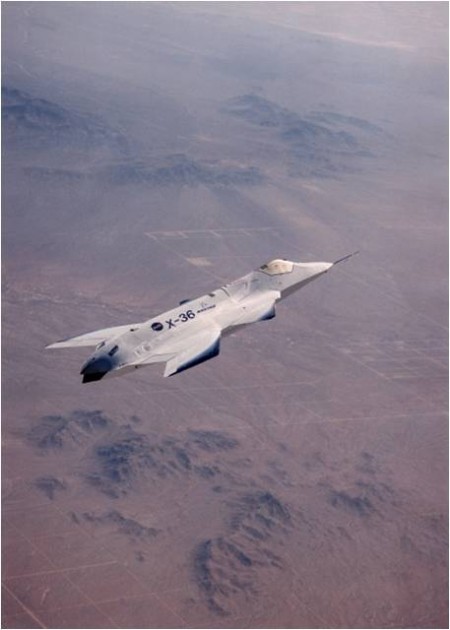
Fifteen-years ago today, the NASA/Boeing X-36 Tailless Fighter Agility Research Aircraft (TFARA) flew its final research mission from the NASA Dryden Flight Research Center (DFRC) at Edwards, California. The remotely piloted vehicle was designed to demonstrate flight control technologies aimed at improving the maneuverability and survivability of future fighter aircraft.
The X-36 was a 0.28-scale version of a notional advanced fighter aircraft. It measured 19 feet in length and had a wingspan of approximately 10 feet. Gross Take-Off Weight (GTOW) was on the order of 1,250 lbs. Power was provided by a Williams International F112 turbofan engine generating a maximum thrust of 700 lbs.
The X-36 did not have a conventional vertical tail and rudder assembly. Rather, the type utilized a unique set of aero-propulsive flight controls that included dual canards, split ailerons and a vectorable nozzle for aircraft directional control. Since the X-36 was longitudinally and directionally unstable, 3-axis flight control was provided via a digital fly-by-wire flight control system.
Boeing manufactured a pair of X-36 airframes. (A review of the historical record indicates that neither vehicle was officially assigned an airframe serial number.) The X-36 was remotely-controlled by a pilot sitting within a virtual cockpit at a ground station. A real-time video feed from a nose-mounted camera aboard the aircraft was transmitted to provide visual information to the pilot. A typical research flight from take-off to landing lasted between 35 to 45 minutes.
The X-36 flight research program began on Saturday, 17 May 1997 at Edwards Air Force Base, California. The last of 31 very successful research flights was flown on Wednesday, 12 November 1997. During this 6-month period, the aircraft amassed a total of 15 hours and 38 minutes of flight time. Peak performance marks included an altitude of 20,200 feet, speed in excess of 230 mph and a maximum angle-of-attack of 40 degrees.
The X-36 was both highly maneuverable, agile and controllable. The aircraft also served as a versatile testbed for testing innovative control law software. Flight testing of the X-36 aircraft measurably improved our understanding of the aerodynamic and flight control characteristics of futuristic aircraft configurations. In short, the X-36 Program was a very well conceived and executed flight test effort.
Happily, both X-36 aircraft survived the flight test program. One of these ships can be seen at the National Museum of the United States Air Force in Dayton, Ohio. The other aircraft is displayed in the Air Force Test Flight Center Museum at Edwards Air Force Base, California.
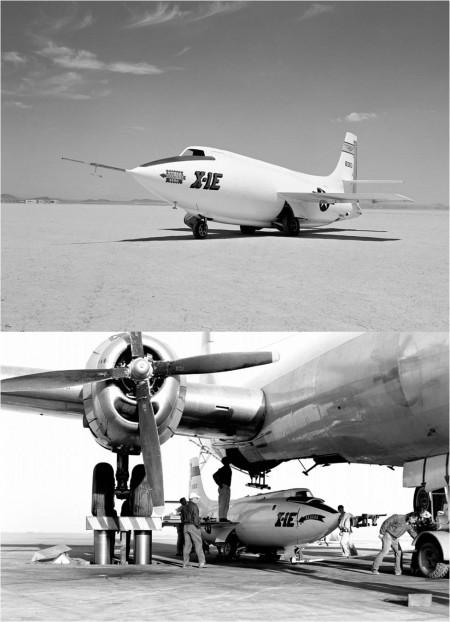
Fifty-four years ago this week, the famed Bell X-1E rocket-powered flight research aircraft flew for the twenty-sixth and final time. The flight marked the close of the highly productive twelve-year flight test history of the first series of X-aircraft.
In the years immediately following World War II, the United States began a relentless pursuit of increasing the speed and altitude capability of manned aircraft. Indeed, the effectual motto of that historic period was “Faster, Higher, and Farther”. The primary flight research tool for accomplishing this daunting objective was the now-famous X-aircraft series.
It all began with the USAF/Bell XS-1 rocket-powered flight research aircraft. With Bell Aircraft test pilot Jack Wollams at the controls, the XS-1 made its first glide flight at Pinecastle Army Airfield, Florida in January of 1946. Twenty-one months later (Tuesday, 14 October 1947), Captain Charles E. “Chuck” Yeager broke the sound barrier when he flew the XS-1 (Ship 1, S/N 46-062) to Mach 1.06 (700 mph).
Less than two years after the XS-1 first achieved supersonic flight, the type established performance records for both speed and altitude. Yeager hit Mach 1.45 (957 mph) in the XS-1 on Friday, 26 March 1948. Then, on Monday, 08 August 1949, USAF Major Frank K. “Pete” Everest soared to 71,902 feet at the controls of the same aircraft.
The USAF/Bell X-1A (S/N 48-1384) took aircraft performance to the next level in 1953 and 1954. In a flight in which he almost lost his life, USAF Major Charles E. “Chuck” Yeager flew the airplane to Mach 2.44 (1,620 mph) on Friday, 12 December 1953. This feat was followed by USAF Major Arthur “Kit” Murray when he flew the craft to an unofficial world altitude record of 90,440 feet on Thursday, 26 August 1954.
Meanwhile, the USAF/Bell X-1B (S/N 48-1385) first flew in September of 1954 with USAF Lt Col Jack Ridley doing the piloting honors. The X-1B was flown to Mach 2.3 (1,541 mph) by Pete Everest in December of 1954. NACA test pilot John B. “Jack” McKay hit an altitude of 62,952 feet in January of 1957. Although neither of these marks exceeded the X-1A’s performance records, the X-1B contributed significantly to the flight research database.
Neither the USAF/Bell X-1C nor USAF/Bell X-1D (S/N 48-1386) fulfilled the measure of their creation. In fact, the X-1C was never constructed. The X-1D made its initial glide flight on Tuesday, 24 July 1951 with Bell Aircraft test pilot Jean “Skip” Ziegler in the cockpit. However, the X-1D crashed to destruction on Wednesday, 22 August 1951 when it had to be jettisoned from its EB-50A launch aircraft due to unresolvable fuel system issues.
The USAF/Bell X-1E was actually a rebuild of the No. 3 XS-1 (S/N 46-063). The airplane’s XLR-11 propulsion system was upgraded via installation of a low-pressure turbopump system. Doing so eliminated the heavy and dangerous high-pressure fuel system utilized in previous X-1 aircraft. Other changes included the use of a new thin wing (4 percent thickness ratio) design and a streamlined, upward-opening canopy. The later feature permitted the first-time installation of an ejection seat in an X-1 vehicle.
The X-1E was flown 26 times between December of 1955 and November of 1958. NACA test pilot Joseph A. Walker flew the first 21 of these missions while fellow NACA test pilot John B. “Jack” McKay piloted the final 5 test sorties. Walker flew the maximum speed and altitude missions. He reached an altitude of 73,458 feet on Wednesday, 15 May 1957 and a speed of Mach 2.22 (1,487 mph) on Tuesday, 08 October 1957.
The final X-1E flight took place on Thursday, 06 November 1958 with Jack McKay at the controls. Although nondescript in terms of performance, the flight was historic in that it was the last of 239 flight tests in the pioneering X-1 series. From 1946 to 1958, a total of seven (7) X-1 aircraft and twenty-eight (28) Bell Aircraft, NACA and USAF pilots flew these missions.
The X-1E was retired after its twenty-sixth flight when structural cracks were discovered in its fuel tanks. Interstingly, this airframe flew 100 of the X-1 series flights (74 as the No. 2 XS-1 and 26 as the X-1E). Today, it is on public display in front of Building 4801 at NASA’s Dryden Flight Research Center (DFRC) at Edwards Air Force Base, California.











